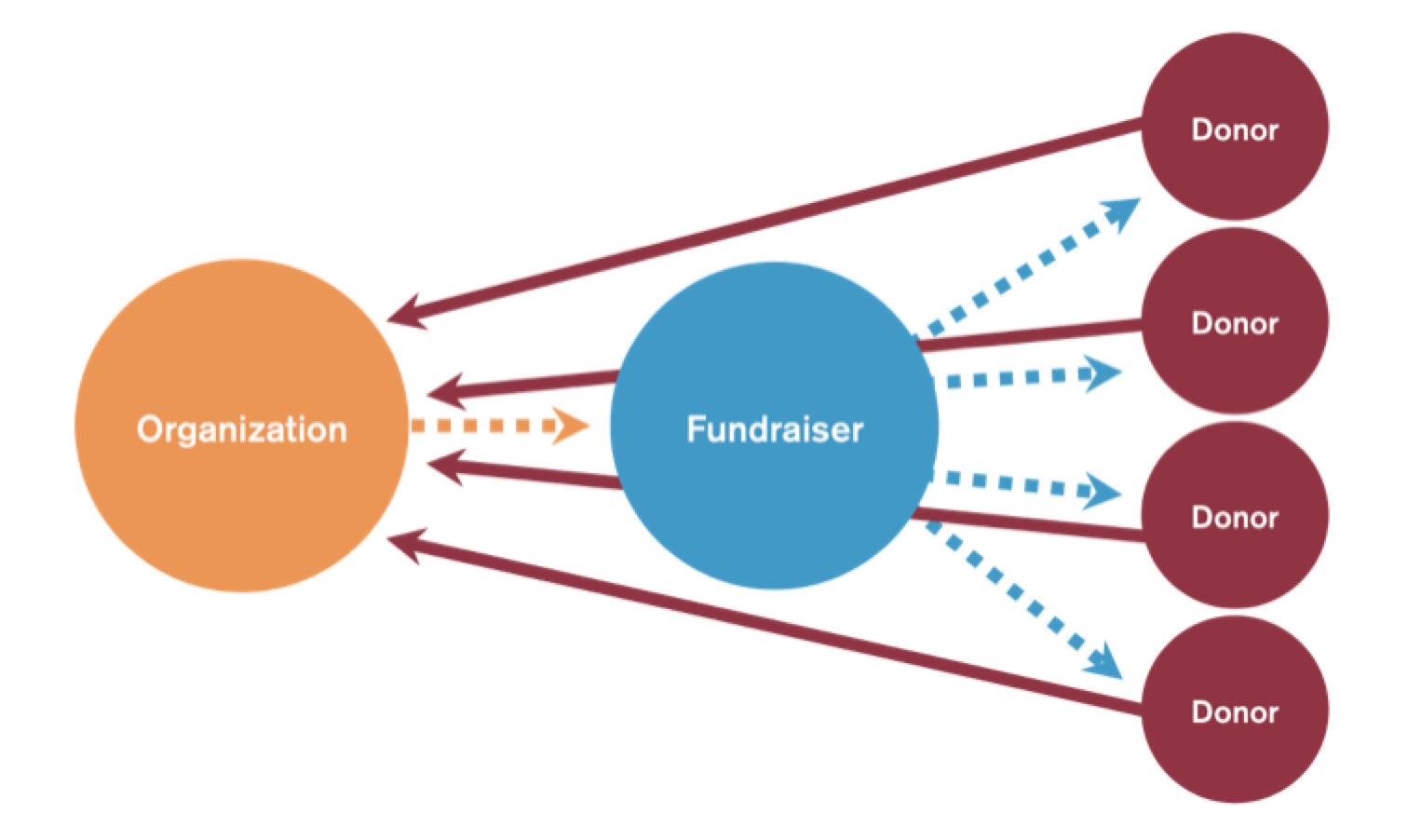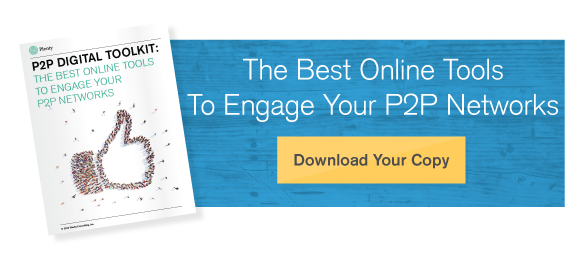Lessons From The Private Sector: Peer-to-Peer Technology
We — as individuals, as groups, as nonprofits, as businesses — operate in an environment that is fundamentally networked, and we’re seeing those networks become increasingly alive and powerful through the application of peer-to-peer technology.
This presents a tremendous opportunity for nonprofits to leverage technology to mobilize their constituents' networks, and expand and recalibrate their fundraising programs. As the nonprofit peer-to-peer space continues to evolve, the ever-expanding for-profit peer-to-peer sector often referred to as the “sharing economy” offers a number of lessons you can learn from as you design solutions meant to mobilize your constituents and their networks.
In the past few years, I’ve participated in the sharing economy in several different ways, but I’ve found it particularly useful when renting cars. Living in Chicago, I don’t own a car so I typically use public transit or bike to get around. In many instances, these modes of transport are quicker and more efficient than braving the road in a personal vehicle.
However, the options become more complicated when leaving the city. I’ve tried everything from Megabus to Amtrak and all the commuter lines in between. Sometimes these long-distance mass transit options work, and sometimes they simply do not get me to where I’m trying to go.
Enter RelayRides, a peer-to-peer car-sharing platform that enables individuals to rent out their own vehicles to other people. Pricing is competitive, set by the owner of the car. Location is convenient as cars are distributed throughout the city. And pickup and drop-off times are very flexible. All of which are huge selling points for me and are negotiated between the owner and the renter.
RelayRides has used technology and collective resources to allow users to solve their own transportation challenges in a way that promotes the efficient allocation of existing resources. While revolutionary in the car-sharing space, this platform is built on many of the same principles that numerous other applications such as Airbnb (booked my honeymoon to Montreal here), Craigslist (found my apartment and my bike here), and Etsy (run my graphic design small business here) use to activate peer-to-peer transactions.
While finding a cheap car or booking interesting accommodations may have different end goals than peer-to-peer fundraising, these strategies operate along the same lines — social networks that are activated through technology. And while the incentives of donors, constituents, and organizations in the nonprofit sector may also differ from the customers, sellers, and businesses that are leading the charge in the for-profit space, the commercial sharing economy offers several key lessons for how nonprofits can think about their technology decisions to maximize their peer-to-peer fundraising strategies.
1. Use technology to create efficiencies and reduce “transaction costs."Technology in the shared economy has dramatically dropped the cost of transactions that were once overwhelmingly expensive (in terms of time, if nothing else). Can you imagine trying to rent a car in your neighborhood without the assistance of the application? Would you manually survey your neighbors? Call all your nearby friends? It wouldn’t be impossible to find a car this way, but it certainly wouldn’t be easy — and even after you put the time into the search, you still may not find exactly what you’re looking for. These are all expenses that technology at scale can greatly diminish.
When implementing a tech solution to mobilize your peer-to-peer fundraising strategy, consider how it creates efficiencies both for you and your constituents. Whether the solution is quicker, more intuitive, or more engaging, make sure that it reduces the “transaction costs” for your constituents to engage with you, donate to your organization, and share with their networks. In fact, go out of your way to make it as easy as possible for your constituents to engage in these ways. You’re already halfway there once they’re on your site — now give them the information and tools they need to support your cause. Remember, design, user interface, and mobile responsive capabilities matter, and if it’s the cause that your constituents are loyal to, they may look to a different organization if your application is clunky.
As we’ve seen through our for-profit peers in the space, tech solutions present an opportunity to create efficiencies for all users – yourself and your organization included. How is your tech solution making it easier for you to understand, interact with, and mobilize your constituents? Through data collection and analysis, fundraising segmentation techniques, and targeted nonprofit analytics, make your technology work for you so that you can dedicate your resources to the other pressing issues your nonprofit is facing.
2. Use technology to create trust.In peer-to-peer, constituents must trust your organization before they will support you. When I used RelayRides for the first time, I was unsure about a lot of things. How do I know that this car is safe? How do I know that the person I’m renting from isn’t going to blame the pre-existing dent in the bumper on me? What happens if I actually do get into an accident?
Your constituents’ questions might look a little different. To what extent will my donation impact the cause? How efficiently is this nonprofit operating — should I be concerned with how my money is being spent? Who else supports this organization? Maybe I should ask my mom or my friend?
As you know, this is just a small sampling of your constituents’ concerns. Luckily, you can use technology to provide answers and information to them upfront and ultimately build trust with them. You can communicate impact quantitatively through quarterly reports, infographics, or direct links to nonprofit accountability websites such as Charity Navigator. You can also convey the impact of your organization qualitatively, through videos of survivors, photos of volunteers, or other storymaking techniques. Let your constituents know what it means to be a part of your organization, how their contribution furthers the cause, and how they can communicate this message to their network to mobilize additional donors.
As both current constituents and potential donors get to know you as an organization, tap into social proof as a way for these users to see how other individuals are already engaging with you. For example, say I’m focused on a specific cause and I’m slightly familiar with your organization, but after seeing your organization’s Facebook metrics and likes, I see that my cousin and one of my close friends are engaged with your organization. I also see that thousands of individuals are following the work that your organization is involved in. I now feel more comfortable with your organization, trusting my cousin and friend in particular as well as the collective voice of your supporters. Look for ways to convey your organization’s social proof, both as it relates to a potential donor’s existing network as well as your larger collective network.
3. Understand what motivates your supporters’ to give and design tech solutions that enhance these incentives.Whether you’re trying to increase participation in your peer-to-peer fundraising event or looking to expand donations through your Giving Tuesday campaign, you need to understand what is driving your participants and donors. Whether your participants are driven by the cause, community, or activity associated with your event, design tech solutions that build off of these motivations and allow your constituents and donors to more effectively engage with the reason they got involved in the first place.
For example, I go to Airbnb to find a place to stay for a long weekend. There’s a good chance that I’ve got at least a general location in mind as well as a budget. Lucky for me, Airbnb allows me to search by city and budget, amongst other criteria. Am I really that lucky? I think not. Airbnb wants me to find what I’m looking for because it turns me into a customer. From searchable calendars by type of event to more information on the cause, use what you know about your constituents and donors to help them find what they’re looking for and use it to drive the design of your site.
Also, consider how your constituents interact through online social networks. How do they want to convey their involvement with your organization? How do they want to raise awareness of your cause? These types of interactions are fundamental to peer-to-peer. Make it easy for your constituents to share success stories, supportive actions, and other content through social media outlets such as Facebook, Twitter, and Instagram. Intuitively placed social sharing buttons on both organization webpages as well as personal fundraising pages will allow your constituents to easily share your organization’s content as well as their interactions with your organization.
Choosing the right tech solution or website design for your peer-to-peer strategy can be overwhelming. The good news is that there are a lot of great examples to learn from. In a TedX Talk, Emily Castor of Lyft, talks about how the role of peer-to-peer ride-sharing application’s within the sharing economy “makes sense for my wallet, makes sense for cities, and makes sense for the environment.” For nonprofits focused on peer-to-peer fundraising, design your tech solution so that it leverages technology and social networks in a way that makes sense for your donors and participants, makes sense for your organization, and makes sense for your cause.
Want more expert advice on how to use technology to grow your peer-to-peer networks? Download your copy of "The P2P Digital Toolkit" today which explores the best digital tools for engaging and growing your supporter networks!
Share this
You May Also Like
These Related Stories

A Introduction To Peer-to-Peer Fundraising
Emerging Trends in Peer-to-Peer Fundraising




No Comments Yet
Let us know what you think